Strategic Plan & EBP Model: Reducing HIV/AIDS Infection & Transmission
VerifiedAdded on 2023/03/31
|5
|819
|314
Report
AI Summary
This report details a strategic plan to reduce HIV/AIDS infection and transmission by integrating the Evidence-Based Practice (EBP) model. The plan emphasizes educating healthcare workers on managing HIV patients, reducing stigmatization, and employing proper dissemination methods. The EBP model's phases—practice, evidence, and translation—are incorporated to address the increasing prevalence of HIV/AIDS. The strategic plan includes identifying contributing factors, increasing the number of healthcare practitioners in leadership roles, focusing on key decision-makers, and managing potential conflicts. The implementation and evaluation of these strategies are crucial for determining their effectiveness and achieving the desired outcome of reduced HIV/AIDS cases. Desklib provides access to this and other solved assignments to aid students in their studies.
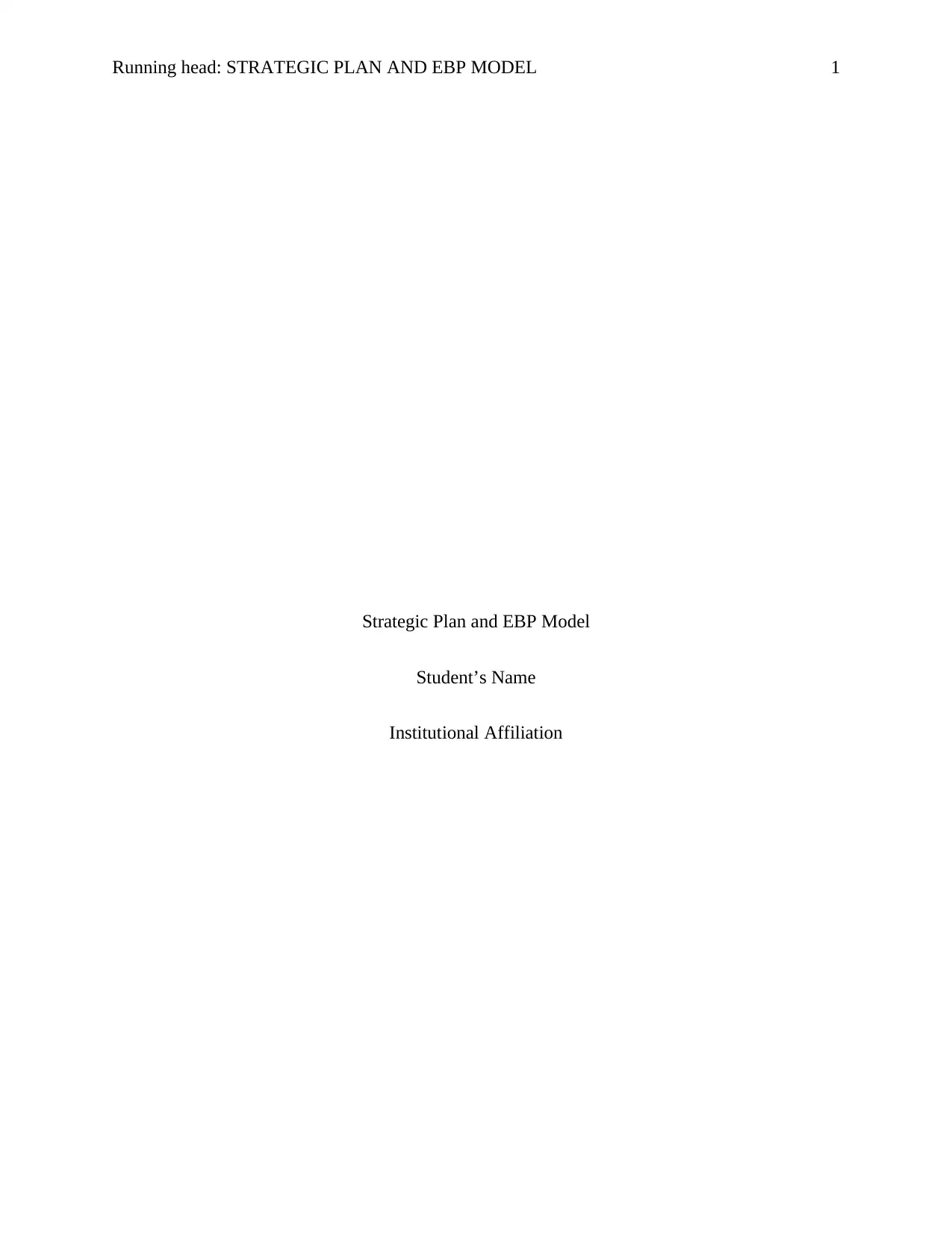
Running head: STRATEGIC PLAN AND EBP MODEL 1
Strategic Plan and EBP Model
Student’s Name
Institutional Affiliation
Strategic Plan and EBP Model
Student’s Name
Institutional Affiliation
Paraphrase This Document
Need a fresh take? Get an instant paraphrase of this document with our AI Paraphraser
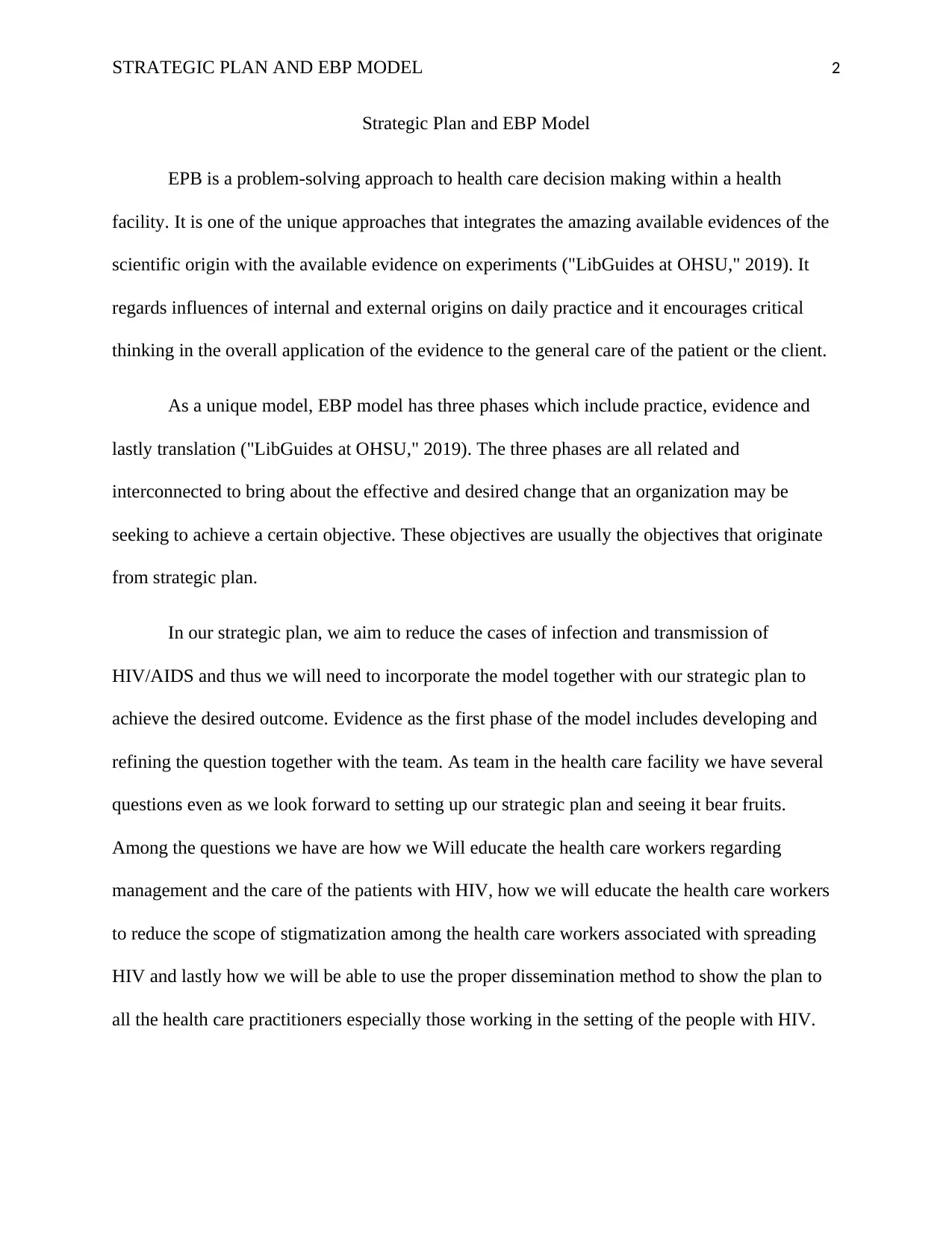
STRATEGIC PLAN AND EBP MODEL 2
Strategic Plan and EBP Model
EPB is a problem-solving approach to health care decision making within a health
facility. It is one of the unique approaches that integrates the amazing available evidences of the
scientific origin with the available evidence on experiments ("LibGuides at OHSU," 2019). It
regards influences of internal and external origins on daily practice and it encourages critical
thinking in the overall application of the evidence to the general care of the patient or the client.
As a unique model, EBP model has three phases which include practice, evidence and
lastly translation ("LibGuides at OHSU," 2019). The three phases are all related and
interconnected to bring about the effective and desired change that an organization may be
seeking to achieve a certain objective. These objectives are usually the objectives that originate
from strategic plan.
In our strategic plan, we aim to reduce the cases of infection and transmission of
HIV/AIDS and thus we will need to incorporate the model together with our strategic plan to
achieve the desired outcome. Evidence as the first phase of the model includes developing and
refining the question together with the team. As team in the health care facility we have several
questions even as we look forward to setting up our strategic plan and seeing it bear fruits.
Among the questions we have are how we Will educate the health care workers regarding
management and the care of the patients with HIV, how we will educate the health care workers
to reduce the scope of stigmatization among the health care workers associated with spreading
HIV and lastly how we will be able to use the proper dissemination method to show the plan to
all the health care practitioners especially those working in the setting of the people with HIV.
Strategic Plan and EBP Model
EPB is a problem-solving approach to health care decision making within a health
facility. It is one of the unique approaches that integrates the amazing available evidences of the
scientific origin with the available evidence on experiments ("LibGuides at OHSU," 2019). It
regards influences of internal and external origins on daily practice and it encourages critical
thinking in the overall application of the evidence to the general care of the patient or the client.
As a unique model, EBP model has three phases which include practice, evidence and
lastly translation ("LibGuides at OHSU," 2019). The three phases are all related and
interconnected to bring about the effective and desired change that an organization may be
seeking to achieve a certain objective. These objectives are usually the objectives that originate
from strategic plan.
In our strategic plan, we aim to reduce the cases of infection and transmission of
HIV/AIDS and thus we will need to incorporate the model together with our strategic plan to
achieve the desired outcome. Evidence as the first phase of the model includes developing and
refining the question together with the team. As team in the health care facility we have several
questions even as we look forward to setting up our strategic plan and seeing it bear fruits.
Among the questions we have are how we Will educate the health care workers regarding
management and the care of the patients with HIV, how we will educate the health care workers
to reduce the scope of stigmatization among the health care workers associated with spreading
HIV and lastly how we will be able to use the proper dissemination method to show the plan to
all the health care practitioners especially those working in the setting of the people with HIV.
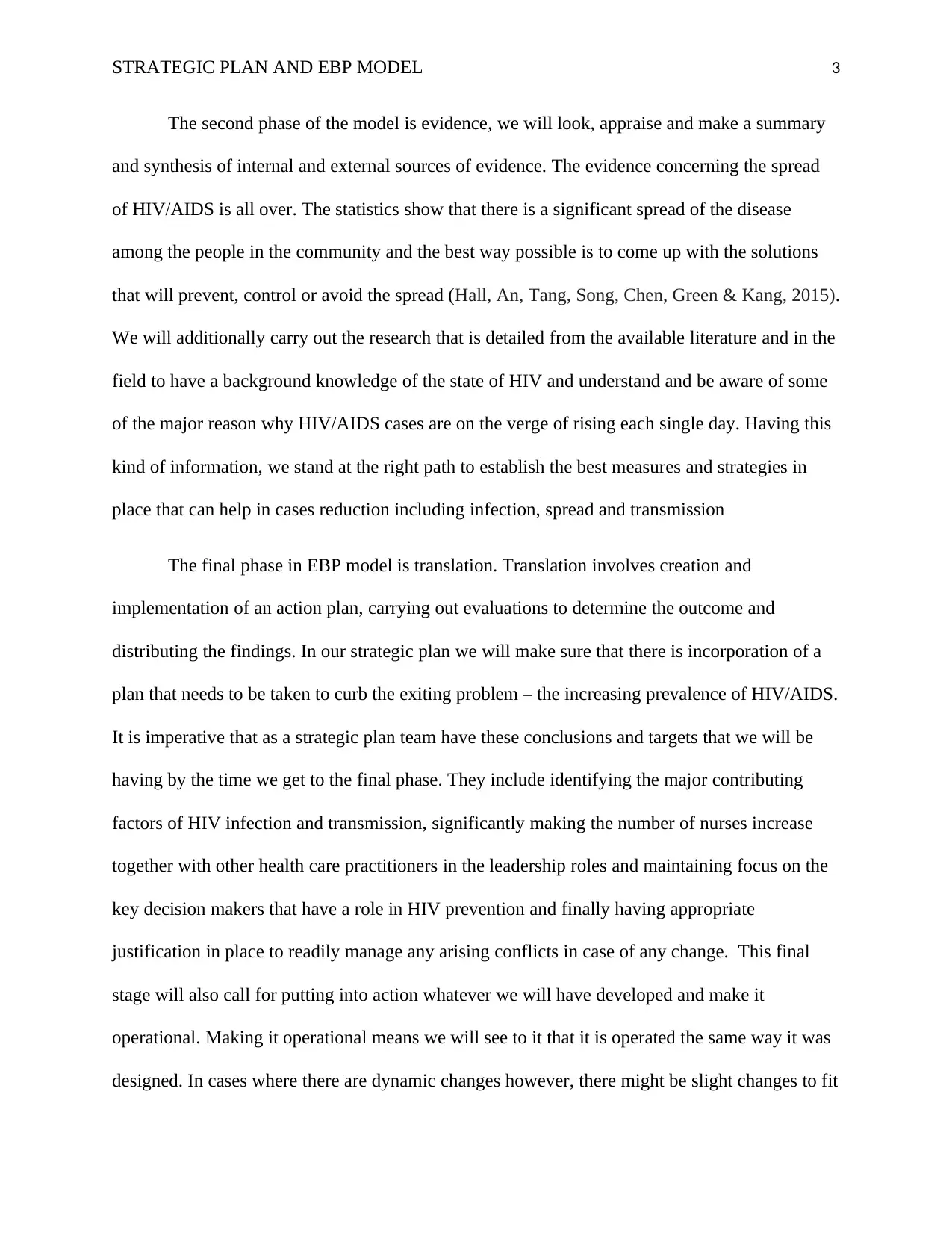
STRATEGIC PLAN AND EBP MODEL 3
The second phase of the model is evidence, we will look, appraise and make a summary
and synthesis of internal and external sources of evidence. The evidence concerning the spread
of HIV/AIDS is all over. The statistics show that there is a significant spread of the disease
among the people in the community and the best way possible is to come up with the solutions
that will prevent, control or avoid the spread (Hall, An, Tang, Song, Chen, Green & Kang, 2015).
We will additionally carry out the research that is detailed from the available literature and in the
field to have a background knowledge of the state of HIV and understand and be aware of some
of the major reason why HIV/AIDS cases are on the verge of rising each single day. Having this
kind of information, we stand at the right path to establish the best measures and strategies in
place that can help in cases reduction including infection, spread and transmission
The final phase in EBP model is translation. Translation involves creation and
implementation of an action plan, carrying out evaluations to determine the outcome and
distributing the findings. In our strategic plan we will make sure that there is incorporation of a
plan that needs to be taken to curb the exiting problem – the increasing prevalence of HIV/AIDS.
It is imperative that as a strategic plan team have these conclusions and targets that we will be
having by the time we get to the final phase. They include identifying the major contributing
factors of HIV infection and transmission, significantly making the number of nurses increase
together with other health care practitioners in the leadership roles and maintaining focus on the
key decision makers that have a role in HIV prevention and finally having appropriate
justification in place to readily manage any arising conflicts in case of any change. This final
stage will also call for putting into action whatever we will have developed and make it
operational. Making it operational means we will see to it that it is operated the same way it was
designed. In cases where there are dynamic changes however, there might be slight changes to fit
The second phase of the model is evidence, we will look, appraise and make a summary
and synthesis of internal and external sources of evidence. The evidence concerning the spread
of HIV/AIDS is all over. The statistics show that there is a significant spread of the disease
among the people in the community and the best way possible is to come up with the solutions
that will prevent, control or avoid the spread (Hall, An, Tang, Song, Chen, Green & Kang, 2015).
We will additionally carry out the research that is detailed from the available literature and in the
field to have a background knowledge of the state of HIV and understand and be aware of some
of the major reason why HIV/AIDS cases are on the verge of rising each single day. Having this
kind of information, we stand at the right path to establish the best measures and strategies in
place that can help in cases reduction including infection, spread and transmission
The final phase in EBP model is translation. Translation involves creation and
implementation of an action plan, carrying out evaluations to determine the outcome and
distributing the findings. In our strategic plan we will make sure that there is incorporation of a
plan that needs to be taken to curb the exiting problem – the increasing prevalence of HIV/AIDS.
It is imperative that as a strategic plan team have these conclusions and targets that we will be
having by the time we get to the final phase. They include identifying the major contributing
factors of HIV infection and transmission, significantly making the number of nurses increase
together with other health care practitioners in the leadership roles and maintaining focus on the
key decision makers that have a role in HIV prevention and finally having appropriate
justification in place to readily manage any arising conflicts in case of any change. This final
stage will also call for putting into action whatever we will have developed and make it
operational. Making it operational means we will see to it that it is operated the same way it was
designed. In cases where there are dynamic changes however, there might be slight changes to fit
⊘ This is a preview!⊘
Do you want full access?
Subscribe today to unlock all pages.

Trusted by 1+ million students worldwide
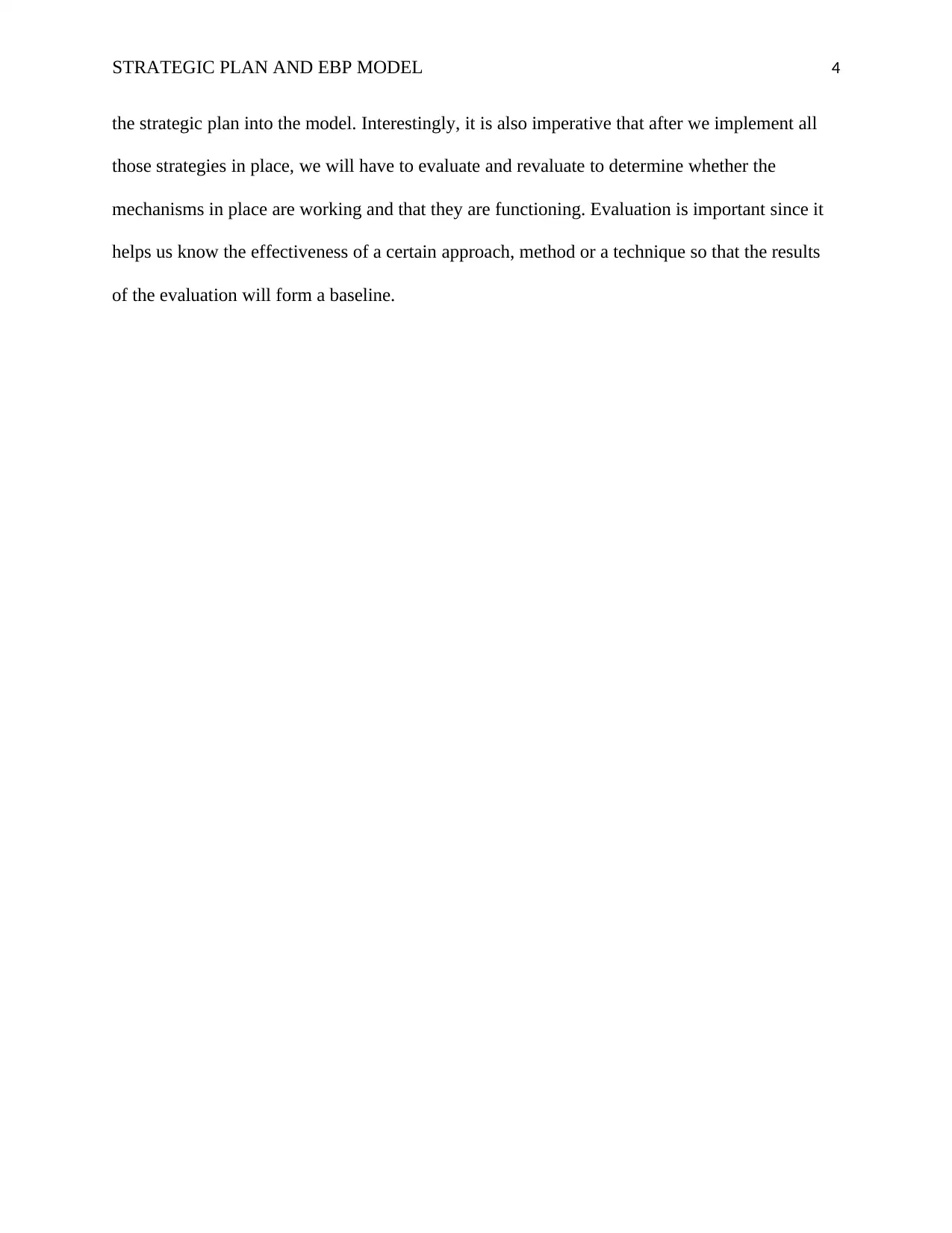
STRATEGIC PLAN AND EBP MODEL 4
the strategic plan into the model. Interestingly, it is also imperative that after we implement all
those strategies in place, we will have to evaluate and revaluate to determine whether the
mechanisms in place are working and that they are functioning. Evaluation is important since it
helps us know the effectiveness of a certain approach, method or a technique so that the results
of the evaluation will form a baseline.
the strategic plan into the model. Interestingly, it is also imperative that after we implement all
those strategies in place, we will have to evaluate and revaluate to determine whether the
mechanisms in place are working and that they are functioning. Evaluation is important since it
helps us know the effectiveness of a certain approach, method or a technique so that the results
of the evaluation will form a baseline.
Paraphrase This Document
Need a fresh take? Get an instant paraphrase of this document with our AI Paraphraser
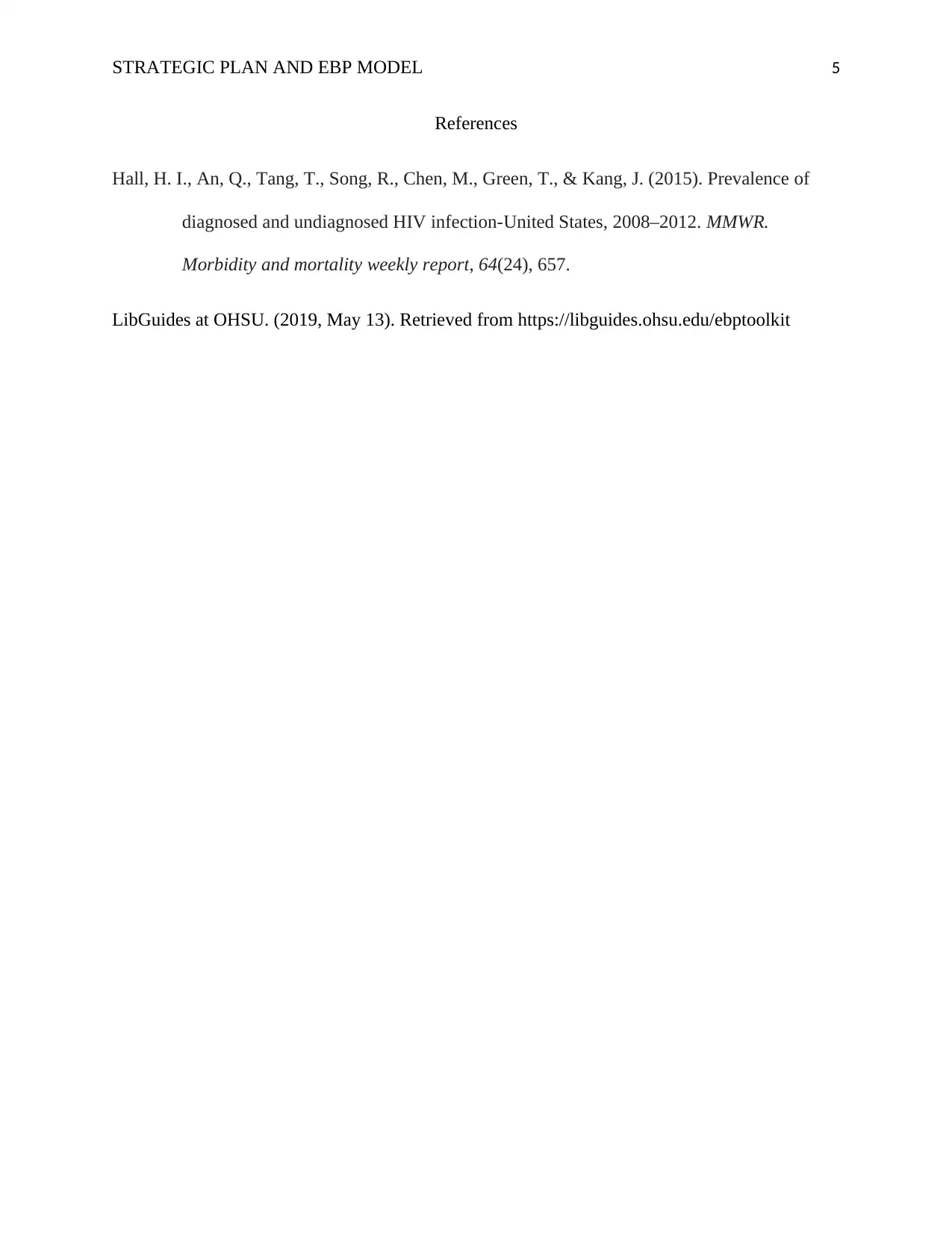
STRATEGIC PLAN AND EBP MODEL 5
References
Hall, H. I., An, Q., Tang, T., Song, R., Chen, M., Green, T., & Kang, J. (2015). Prevalence of
diagnosed and undiagnosed HIV infection-United States, 2008–2012. MMWR.
Morbidity and mortality weekly report, 64(24), 657.
LibGuides at OHSU. (2019, May 13). Retrieved from https://libguides.ohsu.edu/ebptoolkit
References
Hall, H. I., An, Q., Tang, T., Song, R., Chen, M., Green, T., & Kang, J. (2015). Prevalence of
diagnosed and undiagnosed HIV infection-United States, 2008–2012. MMWR.
Morbidity and mortality weekly report, 64(24), 657.
LibGuides at OHSU. (2019, May 13). Retrieved from https://libguides.ohsu.edu/ebptoolkit
1 out of 5
Related Documents
Your All-in-One AI-Powered Toolkit for Academic Success.
+13062052269
info@desklib.com
Available 24*7 on WhatsApp / Email
![[object Object]](/_next/static/media/star-bottom.7253800d.svg)
Unlock your academic potential
Copyright © 2020–2025 A2Z Services. All Rights Reserved. Developed and managed by ZUCOL.



